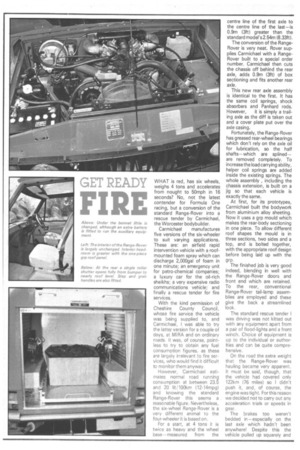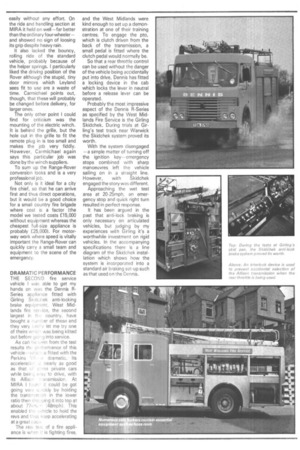GET READY
Page 68

Page 69

If you've noticed an error in this article please click here to report it so we can fix it.
FIRE
WHAT is red, has six wheels, weighs 4 tons and accelerates from nought to 50mph in 16 seconds? No, not the latest contender for Formula One racing, but a conversion of the standard Range-Rover into a rescue tender by Carmichael, the Worcester bodybuilder.
Carmichael manufactures five versions of the six-wheeler to suit varying applications. These are: an airfield rapid intervention vehicle with a roofmounted foam spray which can discharge 2,000gal of foam in one minute; an emergency unit for petro-chemical companies; a luxury car for the oil-rich sheikhs; a very expensive radio communications vehicle; and finally a rescue tender for fire services.
With the kind permission of Cheshire County Council, whose fire service the vehicle was being supplied to, and Carmichael, I was able to try the latter version for a couple of days, at MIRA and on ordinary roads. It was, of course, pointless to try to obtain any fuel consumption figures, as these are largely irrelevant to fire services, who would find it difficult to monitor them anyway.
However, Carmichael estimates normal road running consumption at between 23.5 and 20 lit/100km (12-14mpg) and knowing the standard Range-Rover this seems a reasonable figure. Nevertheless, the six-wheel Range-Rover is a very different animal to the four-wheeler it is based on.
For a start, at 4 tons it is twice as heavy and the wheel base—measured from the centre line of the first axle to the centre line of the last—is 0.9m (3ft) greater than the standard model's 2.54m (8.33ft).
The conversion of the RangeRover is very neat. Rover supplies Carmichael with a RangeRover built to a special order number. Carmichael then cuts the chassis off behind the rear axle, adds 0.9m (3ft) of box sectioning and fits another rear axle.
This new rear axle assembly is identical to the first. It has the same coil springs, shock absorbers and Panhard rods.
However, it is simply a trailing axle as the diff is taken out and a cover plate put over the axle casing.
Fortunately, the Range-Rover has greased rear-wheel bearings which don't rely on the axle oil for lubrication, so the half shafts—which are splined — are removed completely. To in crease the load carrying ability, helper coil springs are added inside the existing springs. The whole assembly , including the chassis extension, is built on a jig so that each vehicle is exactly the same.
At first, for its prototypes, Carmichael built the bodywork from aluminium alloy sheeting. Now it uses a grp mould which makes the rear-body sectioning in one piece. To allow different roof shapes the mould is in three sections, two sides and a top, and is bolted together, with the appropriate roof design before being laid up with the grp.
The finished job is very good indeed, blending in well with the Range-Rover doors and front end which are retained. To the rear, conventional Range-Rover tail-lamp assemblies are employed and these give the back a streamlined look.
The standard rescue tender I was driving was not kitted out with any equipment apart from a pair of flood-lights and a front winch. Choice of equipment is up to the individual or authorities and can be quite comprehensive.
On the road the extra weight that the Range-Rover was hauling became very apparent. It must be said, though, that the vehicle had covered only 122km (76 miles) so I didn't push it, and, of course, the engine was tight. For this reason we decided not to carry out any acceleration trials or speeds in gear.
The brakes too weren't bedded in —especially on the last axle which hadn't been anywhere! Despite this the vehicle pulled up squarely and easily without any effort. On the ride and handling section at IVIIRA it held on well—far better than the ordinary four-wheeler — and showed no sign of loosing its grip despite heavy rain.
It also lacked the bouncy, rolling ride of the standard vehicle, probably because of the helper springs. I particularly liked the driving position of the Rover although the stupid, tiny door mirrors which Leyland sees fit to use are a waste of time. Carmichael points out, though, that these will probably be changed before delivery, for larger ones.
The only other point I could find for criticism was the mounting of the electric winch.
It is behind the grille, but the hole cut in the grille to fit the remote plug in is too small and makes the job very fiddly. However, Carmichael again says this particular job was done by the winch suppliers.
To sum up the Range-Rover conversion looks and is a very professional job.
Not only is it ideal for a city fire chief, so that he can arrive first and thus direct operations, but it would be a good choice for a small country fire brigade where cost is a factor (the model we tested costs £15,000 without equipment whereas the cheapest full-size appliance is probably £25,000). For motorway work where speed is vitally important the Range-Rover can quickly carry a small team and equipment to the scene of the emergency.
DRAMATIC PERFORMANCE THE SECOND fire service vehicle I was able to get my hands on was the Dennis RSeries appliance fitted with Girling Skidonek anti-locking brake equipment. West Midlands fire service, the second largest in the country, have bought a number of these and they very Ejne:y let me try one of theirs wnic was being kilted out before go0 into service.
As can be eeen from the test results the performance of this vehicle-vie ieh is fitted with the Perkins dramatic. • Its acceleratice, nearly as good
as that of ,n-te private cars while beine Ee!sy to drive, with its Allison: Teinsmission. Al MIRA I fc...4-ei it could be got going yen: eeckly by holding the trartse•l!sreen in the lower ratio then dro:T)ing it into top at about 77krre.e ;48mph), This enabled the vehicle to hold the revs and thus 'Keep accelerating at a great nace.
The real test of a fire appliance is when it is fighting fires, and the West Midlands were kind enough to set up a demonstration at one of their training centres. To engage the pto, which is clutch driven from the back of the transmission, a small pedal is fitted where the clutch pedal would normally be.
So that a rear throttle control can be used without the danger of the vehicle being accidentally put into drive, Dennis has fitted a locking device in the cab which locks the lever in neutral before a release lever can be operated.
Probably the most impressive aspect of the Dennis R-Series as specified by the West Midlands Fire Service is the Girling Skidchek. During trials at Girling's test track near Warwick the Skidchek system proved its worth.
With the system disengaged —a simple matter of turning off the ignition key—emergency stops combined with sharp manoeuvres left the vehicle sailing on in a straight line. However, with Skidchek engaged the story was different.
Approaching the wet test area at 20-25mph, an emergency stop and quick right turn resulted in perfect response.
It has been argued in the past that anti-lock braking is only necessary on articulated vehicles, but judging by my experiences with Girling it's a worthwhile investment on rigid vehicles. In the accompanying specifications there is a line diagram of the Skidchek installation which shows how the system is incorporated into a standard air braking set-up such as that used on the Dennis.








































































































































